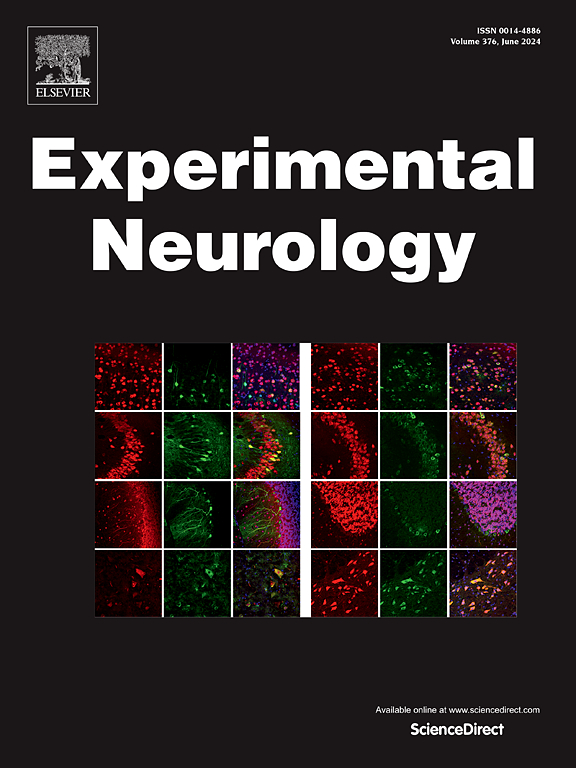中度儿童创伤性脑损伤后环境富集诱导的认知恢复与肠道微生物群和神经炎症有关。
IF 4.6
2区 医学
Q1 NEUROSCIENCES
引用次数: 0
摘要
儿童创伤性脑损伤(TBI)是一个重要的健康问题,但儿童获得康复治疗的机会仍然有限。环境富集(Environmental enrichment, EE)是一种促进脑外伤后行为恢复和减少神经炎症的临床前神经康复模型。虽然肠道微生物群最近已成为治疗成人创伤性脑损伤后遗症的潜在治疗靶点,但其在儿童创伤性脑损伤后康复中的作用仍不清楚。因此,我们的目的是评估EE对儿科TBI临床前模型中肠道微生物群的影响及其与认知和小胶质细胞形态的相关性。雄性大鼠在出生后第21天接受中度或假损伤的皮质控制,然后随机分配到EE或标准(STD)住房。损伤后第14-19天采用Morris水迷宫(MWM)评价认知能力。损伤后第21天观察小胶质细胞形态和盲肠微生物群。认知缺陷和同侧皮质小胶质细胞激活增加在性传播疾病收容的TBI大鼠中被观察到,但在情感表达中没有。TBI降低了微生物群α-多样性,而PERMANOVA分析显示,TBI和EE都改变了微生物群β-多样性。此外,回归模型表明,同侧皮层的小胶质细胞形态和罗伊氏乳杆菌预测行为结果,而Prevotellaceae NK3B31与小胶质细胞形态相关。数据表明,EE减轻了tbi引起的肠道微生物群的改变,并且EE、微生物群和小胶质细胞形态之间存在复杂的相互作用,可以预测儿科大鼠的行为恢复。本文章由计算机程序翻译,如有差异,请以英文原文为准。

Environmental enrichment-induced cognitive recovery after a moderate pediatric traumatic brain injury is associated with the gut microbiota and neuroinflammation
Pediatric traumatic brain injury (TBI) is a significant health concern, yet access to rehabilitation therapies for children remains limited. Environmental enrichment (EE) is a preclinical model of neurorehabilitation that promotes behavioral recovery and reduces neuroinflammation after TBI. While the gut microbiota has recently emerged as a potential therapeutic target for treating TBI sequelae in adults, its role in recovery after pediatric TBI remains unclear. Therefore, our aim was to assess the effect of EE on gut microbiota and its correlation with cognition as well as microglial morphology in a preclinical model of pediatric TBI. Male rats underwent a controlled cortical impact of moderate severity or sham injury at postnatal day 21 and were then randomly assigned to either EE or standard (STD) housing. Cognition was evaluated using the Morris water maze (MWM) on post-injury days 14–19. Microglial morphology and caecum microbiota was characterized on post-injury day 21. Cognitive deficits and increased microglial activation in the ipsilateral cortex were observed in the STD-housed TBI rats but not those in EE. TBI decreased microbiota α-diversity, while PERMANOVA analysis showed that both TBI and EE modified microbiota β-diversity. Furthermore, regression models indicated that microglial morphology in the ipsilateral cortex and Lactobacillus reuteri predicted behavioral outcomes, while Prevotellaceae NK3B31 was associated with microglial morphology. The data suggest that EE mitigates TBI-induced alterations in gut microbiota and that there is a complex interplay between EE, microbiota and microglial morphology that predicts behavioral recovery in pediatric rats.
求助全文
通过发布文献求助,成功后即可免费获取论文全文。
去求助
来源期刊

Experimental Neurology
医学-神经科学
CiteScore
10.10
自引率
3.80%
发文量
258
审稿时长
42 days
期刊介绍:
Experimental Neurology, a Journal of Neuroscience Research, publishes original research in neuroscience with a particular emphasis on novel findings in neural development, regeneration, plasticity and transplantation. The journal has focused on research concerning basic mechanisms underlying neurological disorders.
 求助内容:
求助内容: 应助结果提醒方式:
应助结果提醒方式:


